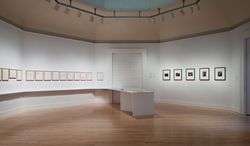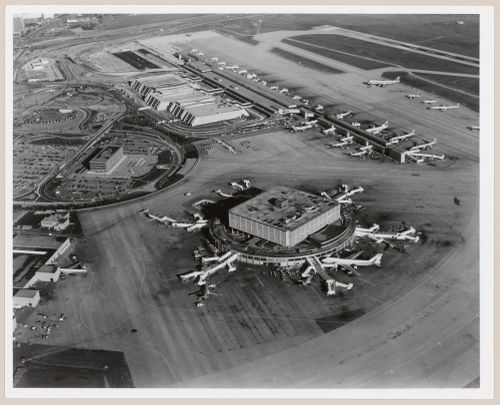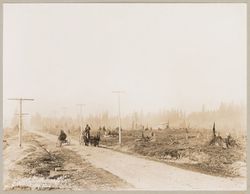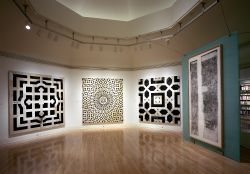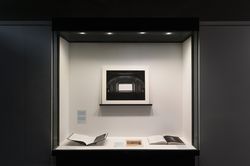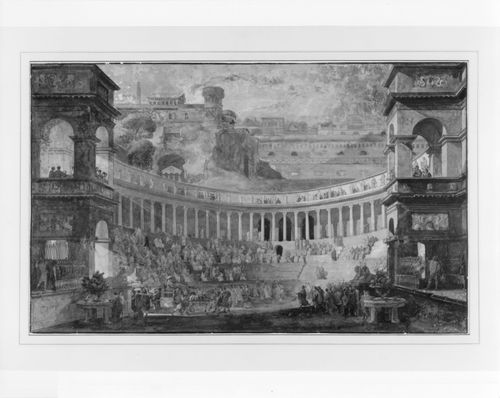Portuguese architect Álvaro Siza travelled to Peru in 1995 with his usual baggage: only a few changes of clothes, some books of poetry, and a single sketchbook. This was the toolkit he used to interpret the voyage and integrate it into his architecture. More than half a century earlier, Peruvian photographer Martín Chambi had taken his famous series of portraits of the(...)
Octagonal gallery
26 January 2012 to 29 April 2012
Alturas de Machu Picchu: Martín Chambi – Álvaro Siza at work
Actions:
Description:
Portuguese architect Álvaro Siza travelled to Peru in 1995 with his usual baggage: only a few changes of clothes, some books of poetry, and a single sketchbook. This was the toolkit he used to interpret the voyage and integrate it into his architecture. More than half a century earlier, Peruvian photographer Martín Chambi had taken his famous series of portraits of the(...)
Octagonal gallery
PH2009:0005:061
Description:
On verso of photograph, a handwritten note by photographer reads: "A copy from this series featuring original terminal no. 1 was selected by Carl Sagan to be placed aboard Voyager II for its flight to deep outer space. It is the sole canadian image carried".
architecture
1978
Toronto (Pearson) International Airport, Mississauga, Ontario
Actions:
PH2009:0005:061
Description:
On verso of photograph, a handwritten note by photographer reads: "A copy from this series featuring original terminal no. 1 was selected by Carl Sagan to be placed aboard Voyager II for its flight to deep outer space. It is the sole canadian image carried".
architecture
Shaughnessy House Keyword(s):
research fellow 2022, seminar, research, Desirée Valadares, infrastructure, railway, highway, colonial history
10 November 2022, 6pm
Shaughnessy House Keyword(s):
research fellow 2022, seminar, research, Desirée Valadares, infrastructure, railway, highway, colonial history
This exhibition presents American architect Ben Nicholson’s search for order, meaning, and logic in a world of art, science, and mystery. The Laurentian Library in Florence, a masterwork by Michelangelo designed in 1524–25, contains fifteen pairs of terra cotta panels bearing complex geometric patterns that have been long hidden from view. Nicholson studied the panels at(...)
Octagonal gallery
11 December 1996 to 9 March 1997
Uncovering Geometry: Ben Nicholson at the Laurentian Library
Actions:
Description:
This exhibition presents American architect Ben Nicholson’s search for order, meaning, and logic in a world of art, science, and mystery. The Laurentian Library in Florence, a masterwork by Michelangelo designed in 1524–25, contains fifteen pairs of terra cotta panels bearing complex geometric patterns that have been long hidden from view. Nicholson studied the panels at(...)
Octagonal gallery
textual records, photographs
DR2012:0012:085:004
Description:
File containing documents in French, including 2 colour slides, correspondence, notes, photocopies from « Trois: revue d'écriture et d'érudition » (vol. 6, nos. 2-3), and a program related to the exhibition "Corriger les lieux, après la photographie de voyage" at the Maison de la culture Frontenac in Montreal. Original folder inscribed in graphite: DAZIBAO: CORRIGER LES LIEUX AVRIL, 1991
1990-1991
Photographs, correspondence, notes, and a program related to the exhibition "Corriger les lieux, après la photographie de voyage"
Actions:
DR2012:0012:085:004
Description:
File containing documents in French, including 2 colour slides, correspondence, notes, photocopies from « Trois: revue d'écriture et d'érudition » (vol. 6, nos. 2-3), and a program related to the exhibition "Corriger les lieux, après la photographie de voyage" at the Maison de la culture Frontenac in Montreal. Original folder inscribed in graphite: DAZIBAO: CORRIGER LES LIEUX AVRIL, 1991
textual records, photographs
1990-1991
A revolutionary approach to the relationship between building and landscape, which shaped them together according to peculiarly American ideals, is the subject of Frank Lloyd Wright: Designs for an American Landscape, 1922–1932. In this exhibition, the CCA reconstructs five unbuilt, visionary projects that imagined nothing less than a new American landscape, integrating(...)
Main galleries
18 June 1996 to 29 September 1996
Frank Lloyd Wright: Designs for an American Landscape, 1922-1932
Actions:
Description:
A revolutionary approach to the relationship between building and landscape, which shaped them together according to peculiarly American ideals, is the subject of Frank Lloyd Wright: Designs for an American Landscape, 1922–1932. In this exhibition, the CCA reconstructs five unbuilt, visionary projects that imagined nothing less than a new American landscape, integrating(...)
Main galleries
Mirrors / Miroirs
Mirrors/ Miroirs is conceived through an indirect dialogue with the exhibition Besides, History: Go Hasegawa, Kersten Geers, David Van Severen, a project rooted in the shared references and resonances between the work of two contemporary practices in the presence of history. If Besides, History is premised on impressions of one office’s work registered through(...)
Hall cases
22 June 2017 to 14 January 2018
Mirrors / Miroirs
Actions:
Description:
Mirrors/ Miroirs is conceived through an indirect dialogue with the exhibition Besides, History: Go Hasegawa, Kersten Geers, David Van Severen, a project rooted in the shared references and resonances between the work of two contemporary practices in the presence of history. If Besides, History is premised on impressions of one office’s work registered through(...)
Hall cases
archives
Level of archival description:
Fonds
Roger D’Astous fonds
AP060
Synopsis:
Le fonds témoigne des activités personnelles et professionnelles de Roger D'Astous, de sa carrière d'architecte et de sa contribution à l'architecture québécoise. Il nous renseigne sur sa formation académique à l'École des Beaux-Arts de Montréal, sur son séjour en tant qu'apprenti à l'atelier de Frank Lloyd Wright à Taliesin (Arizona et Wisconsin), ainsi que sur sa pratique professionnelle en tant qu'architecte. Ces projets professionnels sont principalement concentrés au Québec, à Montréal, en Montérégie, dans les Laurentides, à Laval, ainsi qu'en Ontario (dont à Brockville et à Kingston). Le fonds contient, entre autres, 4 100 dessins d’architecture, 2 581 documents photographiques, 7 maquettes et 1,23 m.l. de documents textuels.
1893-1998, surtout 1951-1998
Roger D’Astous fonds
Actions:
AP060
Synopsis:
Le fonds témoigne des activités personnelles et professionnelles de Roger D'Astous, de sa carrière d'architecte et de sa contribution à l'architecture québécoise. Il nous renseigne sur sa formation académique à l'École des Beaux-Arts de Montréal, sur son séjour en tant qu'apprenti à l'atelier de Frank Lloyd Wright à Taliesin (Arizona et Wisconsin), ainsi que sur sa pratique professionnelle en tant qu'architecte. Ces projets professionnels sont principalement concentrés au Québec, à Montréal, en Montérégie, dans les Laurentides, à Laval, ainsi qu'en Ontario (dont à Brockville et à Kingston). Le fonds contient, entre autres, 4 100 dessins d’architecture, 2 581 documents photographiques, 7 maquettes et 1,23 m.l. de documents textuels.
archives
Level of archival description:
Fonds
1893-1998, surtout 1951-1998
archives
Level of archival description:
Fonds
Robert Duchesnay fonds
AP115
Synopsis:
Le Fonds Robert Duchesnay consiste en une série de photographies montrant les divers structure (principalement des dômes géodésiques) conçus ou influencée par R. Buckminster Fuller. Les photographies, prises par l'artiste et photographe montréalais Robert Duchesnay, ont été créées entre 1985 et 1992.
1985-1992
Robert Duchesnay fonds
Actions:
AP115
Synopsis:
Le Fonds Robert Duchesnay consiste en une série de photographies montrant les divers structure (principalement des dômes géodésiques) conçus ou influencée par R. Buckminster Fuller. Les photographies, prises par l'artiste et photographe montréalais Robert Duchesnay, ont été créées entre 1985 et 1992.
archives
Level of archival description:
Fonds
1985-1992
The Triumph of Hannibal
DR1984:1641
Description:
- The turbaned figure being carried into the theater seated on a litter certainly refers to a non-Roman figure, possibly Hannibal. Behind this figure is a theater and an imaginary town on a hill. The town buildings recall the Sicilian monuments in the 'Voyage pittoresque ou description des royaumes de Naples et de Sicile' published by the Abbé de Saint-Non in Paris between 1781 and 1786. Desprez interrupted his studies at the French Academy in Rome from December 1777 to January 1779 to accompany Dominique Vivant Denon and several other artists to Naples and Sicily in order to make drawings for this publication. The town buildings also recall several buildings Desprez planned in Stockholm while stage designer and architect to Gustavus III of Sweden from 1784 to 1792.
theatre design
ca. 1780-1790
The Triumph of Hannibal
Actions:
DR1984:1641
Description:
- The turbaned figure being carried into the theater seated on a litter certainly refers to a non-Roman figure, possibly Hannibal. Behind this figure is a theater and an imaginary town on a hill. The town buildings recall the Sicilian monuments in the 'Voyage pittoresque ou description des royaumes de Naples et de Sicile' published by the Abbé de Saint-Non in Paris between 1781 and 1786. Desprez interrupted his studies at the French Academy in Rome from December 1777 to January 1779 to accompany Dominique Vivant Denon and several other artists to Naples and Sicily in order to make drawings for this publication. The town buildings also recall several buildings Desprez planned in Stockholm while stage designer and architect to Gustavus III of Sweden from 1784 to 1792.
theatre design
